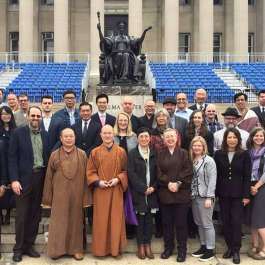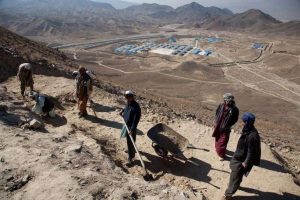Weaving the Buddha into the Burmese identity
Legends are what fill the uncertain space between history and fiction. Some of the most popular legends tell where historical figures might have gone: did Jesus Christ go to India and learn the values of non-violence? Did the Virgin Mary flee to the shores of France? Did the first human, Adam, really leave a footprint on a mountain in Sri Lanka? Although there is little to no evidence for the veracity of these legends, the tales themselves can tell us plenty about the beliefs and self-perception of the communities that created and transmitted them.
Of particular pride to the Burmese is the legend of the Buddha’s visits to Myanmar. The Myanmar oral tradition and the Sasanavamsa (a record of the history of Burmese Buddhism) mention several such visits. Up to the present, the people of Myanmar also established a number of pilgrimage sites to match these visits. The Pali Mahavagga mentions two merchants, Tapussa and Bhallika from Ukkala (present-day Okkalapa near Yangon, but some say it is Orissa in India), who were the first lay disciples of the Buddha. While traveling, they saw the Buddha meditating under a tree and offered rice cakes and honey to him. They took refuge in the Buddha and in the Dhamma (the Sangha, the third refuge, did not exist yet).
Much has been written about Tapussa and Bhallika’s social status and Buddhism’s symbiotic relationship with merchants and traders. Significant also is the beginning of the use of Buddha images as a substitute for the Buddha’s presence. When departing, Tapussa and Bhallika asked the Buddha for an object to worship and he gave them hairs from his head. After they returned from their journey, they enshrined the hairs in a stupa in the great Shwedagon pagoda in Yangon, Myanmar.
The use of the Buddha image also occurs in Burmese historiography, which claims that the Buddha visited Arakan during the reign of Candrasuriya, the king of Dhannavati, to preach Dhamma for one week. Before the Buddha departed, the king requested him to leave an image to worship in his absence. The Buddha assented and an image was built and named Mahamuni. The image remained in its original location until 1784. During the rule of king Bodawpaya (1745 – 1819), the image was transported to Mandalay and enshrined in a special pagoda (Harvey, History of Burma, p. 268).
According to the Sasanavamsa, a merchant called Punna from Sunaparatna (traditionally identified with Aparanta in Myanmar, which is on the right bank of the Irrawaddy River near Pagan, but Bhikkhu Bodhi and Nanamoli say it is in Maharashtra, India) went to Sravasthi on business and heard a discourse of the Buddha there. After being converted and ordained, he returned to his native home, gathered disciples and built a monastery of red sandalwood. (see Punnovada Sutta, Majjhimanikaya 145 and Punna Sutta, Samyuttanikaya, PTS – iv.60). The Buddha visited and spent one week there, accompanied by five hundred arahants. Burmese tradition claims that he left behind a footprint for veneration by a river called Nammada, near Saccabandha Mountain. Another footprint was left in the rock of the mountain which became an important place of pilgrimage.
From the Irawaddy through Chittagong to India
But how did the Buddha get to Myanmar? There is an oral tradition that suggests the Buddha arrived by going through the Chittagong region. There is no reliable evidence for this, but there remain stories that he came to Kajangala (near Rajmahal hills in the east of Jharkhand in India) and gave two discourses to his followers. The Divyavadana (21 – 22) extends Kajangala further to the east, to the point that the scholar Cunningham argued it should be identified with Mahasthangarh, near Bagora town in present-day Bangladesh. Therefore, it is possible that the Buddha visited Bangladesh.





It is difficult to explain the abundance of Buddhist landmarks in Bangladesh without alluding to an early relationship between the area and the ancient Buddhists. The locale called ‘Cakrashala’ is one of the most important. It is situated at Haidgoan Union in Patiya Upazila, near Chittagong town. Although there are several theories about the origin of the name ‘Cakrashala’, one reflects the Buddha’s journey to Myanmar. The folk tale goes that the Buddha rested here on the return journey from Myanmar. He practiced cankramana (walking meditation) as a part of the contemplation of rest, and for that reason this place was called ‘Cakrashala’.
In his article ‘Buddhist king Jayacandra’s capital – 1500 year old Buddhist temple Pharatara’(01/02/2010, Dainik Sangram, a Bengali daily newspaper), Omar Farooq mentioned a Chittagong site called ‘Pharatara Temple’. It is 1500 years old and located at Haidgoan Union in modern-day Patiya sub-district.
This place was the ancient capital of the Arakan king Jayacandra. Here also was a temple founded by the famed scholar from Bengal’s Pala Empire, Atish Dipankar. According to researchers and archaeologists, Atish Dipankar visited Cakrashala before moving on to Tibet. Scholars say he established the Pandit Vihara (University) on the hills of Anowara Upazila, southwest Patiya. Pharatara Temple itself was built on the extant Cakrashala site.
The second Sangharaja of Bangladesh, Ven. Purnacar (1837 – 1909), and Jagatcandra Mahathera (dates uncertain) reconstructed the temple in the late 19th century after centuries of disrepair. Several renovations were attempted afterwards, complete with a pond in front of the temple for pilgrims. Recently, a boundary wall with a lovely arcade was built. Sadly, there are no longer any local Buddhists here but to their immense credit, some Muslim residents watch over the temple and attend to the monks who visit. The Buddhist legacy lives on through Chaitra Sankranti, a cultural festival organized by the Buddhist community at the Cakrashala Temple (which follows the Bengali New Year). This festival remains an important component of Bengali culture and tradition.
Although modern Western-trained scholars dismiss the stories of the Buddha’s journey to Myanmar, many in Myanmar remain eager to trace their adoption of Buddhism to its founder’s days. The book Sasanavamsa interpret the Sunaparatna as the west bank of the Irawaddy River. If this is true, then it is possible that the Buddha did go to Myanmar through Bangladesh, and that the oral tradition about the Buddha’s rest at Cakrashala is authentic. But even if not, these folk legends remain crucial to the identity of both Burmese and Bangladeshi Buddhists.






